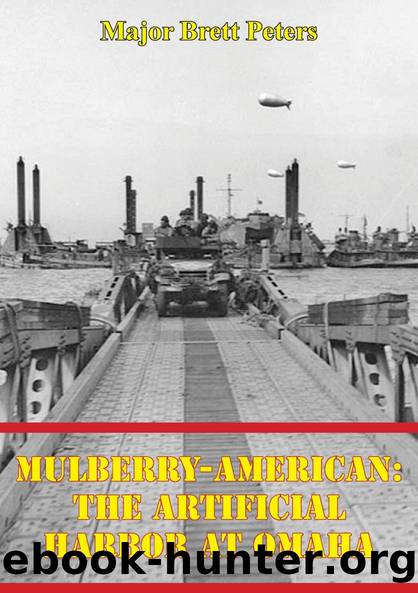Mulberry-American: The Artificial Harbor At Omaha by Major Brett Peters

Author:Major Brett Peters [Peters, Major Brett]
Language: eng
Format: epub
Tags: History, Military, United States, Europe, General, Germany, Special Forces
ISBN: 9781786250742
Google: lKxvCwAAQBAJ
Publisher: Pickle Partners Publishing
Published: 2015-11-06T05:07:58+00:00
CHAPTER 4 â MULBERRY A OPERATIONS
For the Mulberry men, June of 1944 came all too quickly. The time had arrived to put into practice all that Force Mulberry had trained for and to operationally deploy the technological innovation in amphibious warfare they had worked on so diligently. The Germans could not have overlooked what the Allies were preparing for and planned to accomplish. Any engineer could look at photographs of the massive Phoenix caissons at Selsey Bill and other locations and surmise precisely what they were intended for. In fact, in a propaganda radio broadcast weeks before the invasion, William Joyce, the personality known to the Allies as Lord Haw Haw, addressed the men of Force Mulberry directly. We know, said Joyce, âexactly what you intend to do with those concrete caissons: you intend to sink them off our coast in the assault. Well, weâre going to help you, boys! We'll save you some trouble. When you come to get underway, weâre going to sink them for you.â{58}
Of particular concern to Task Force 128 were the five German destroyers and eleven torpedo boats known to patrol the English Channel. With his broadcast Lord Haw Haw caused much distress to the task force personnel. The Germans had stated they knew what Mulberry was, they knew where Mulberry was, and intended to sink the massive caissons when the attempt was made to cross the channel. Travelling aboard a six story block of concrete at 3 knots probably was not the most enjoyable ride, knowing the danger lurking.
Pre-invasion intelligence briefings in early June did not give the personnel of Task Force 128 any more comfort about what lay ahead. Sustaining the force was Force Mulberryâs responsibility and Force Mulberry had to build faster than the Germans could mobilize to counterattack. Captain Dayton Clark received word that estimates of the number of German divisions available in Western Europe to counter the Allied invasion in France had raised from fifty three to over sixty divisions. Clark learned that six Allied infantry divisions and two airborne divisions would immediately face two Panzer divisions in the direct invasion area.{59} The Allied plan was to have a total of thirteen divisions on shore by D+3. According to the early June briefing received by Captain Clark, intelligence estimated that the Allies would face eighteen to twenty German divisions by D+3.{60} Clark had his mission, knew how much depended on him and his men, and was driven to succeed. Clarkâs men would accomplish the mission no matter what the cost.
On 4 June 1944 General Eisenhower delayed the invasion from 5 June to 6 June due to the weather. Captain Clark was advised of the weather delay and finalized preparations to be on the coast the morning of 7 June. The groundwork of staff and personnel moving to the far shore was complete by 5 June and Captain Clark and his deputy, Commander Alfred Stanford, U.S. Navy Reserve, embarked on small convoy escort ships, as part of convoy EWC1A sailing from England.
Download
This site does not store any files on its server. We only index and link to content provided by other sites. Please contact the content providers to delete copyright contents if any and email us, we'll remove relevant links or contents immediately.
The Radium Girls by Kate Moore(11935)
100 Deadly Skills by Clint Emerson(4845)
Rise and Kill First by Ronen Bergman(4706)
The Templars by Dan Jones(4630)
The Doomsday Machine by Daniel Ellsberg(4421)
The Rape of Nanking by Iris Chang(4141)
Killing England by Bill O'Reilly(3953)
Hitler in Los Angeles by Steven J. Ross(3902)
Stalin by Stephen Kotkin(3885)
12 Strong by Doug Stanton(3511)
Hitler's Monsters by Eric Kurlander(3270)
Blood and Sand by Alex Von Tunzelmann(3140)
The Code Book by Simon Singh(3078)
Darkest Hour by Anthony McCarten(3072)
The Art of War Visualized by Jessica Hagy(2945)
Hitler's Flying Saucers: A Guide to German Flying Discs of the Second World War by Stevens Henry(2716)
Babylon's Ark by Lawrence Anthony(2622)
The Second World Wars by Victor Davis Hanson(2485)
Tobruk by Peter Fitzsimons(2448)
